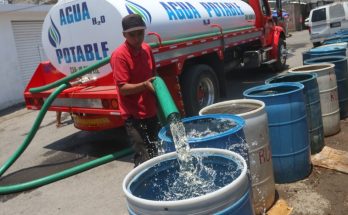By Alejandro Angulo
Recently the “Manual on the Adjudication of Fundamental Rights and the Environment” was released as a joint initiative of the Center for Constitutional Studies of the Supreme Court of Justice of the Nation and the Federal Judicial Training School. It seeks to “provide a general overview of the international and Mexican legal frameworks that define the content and scope of the right to a healthy environment as well as didactic tools that contribute to informing judicial decision-making processes in this field which demand an increasingly specialized approach by judges.” (Juárez Mendoza, Consuelo, 2022, Supreme Court of Justice of the Nation).
This work addresses the scientific evidence that explains the environmental problems that have led to the declaration of a global emergency by the United Nations and a climate emergency by the Inter-American Commission on Human Rights.
It can be observed that Mexican constitutional jurisprudence has embraced the doctrine of rights of nature—making a key and precise clarification that considers «the essential core of protection of the right to a healthy environment as nature itself due to its intrinsic value.»
Additionally, the document describes the structure of the overarching environmental legislation indicating the following: objectives, concepts, principles, policy instruments, criteria, acts of authority, and inspection and surveillance. This would be the process and hierarchy that needs to be observed as there may be situations where two or more contradictory instruments or regulatory frameworks converge.
In this regard, it is considered that the stages of state action begin with environmental policy instruments which start with planning. Planning corresponds to the environmental protection content that must necessarily be incorporated into national, state, and municipal planning and is developed through programmatic instruments derived from this national planning. However, in various national, state, and municipal legislations there are other environmental policy instruments such as ecological zoning instruments (whether national, regional, or local) for land use and regulations on human settlements as well as economic instruments that are divided into three categories: fiscal instruments, financial instruments, and market instruments
The next stage of action involves not only the state, understood as the administrative authority proper, but also private individuals. This stage corresponds to the definition of protection and conservation criteria for natural elements to be protected such as air, water, soil, flora, fauna, and nonrenewable natural resources among others.
The Manual states that the stage of action in which environmental principles and criteria are translated into specific rules is related to acts of authority that establish obligations and define procedures for compliance with these obligations and for asserting the rights that individuals have against the state regarding the use of natural elements.
Finally, there is the stage of inspection and surveillance which is how the state can verify compliance with the objectives of the law as well as the suitability and effectiveness of the principles, criteria, instruments, and rules contained in each of the general laws related to environmental matters.
It is worth noting that the Manual includes a cardinal theme which is the conservation objects in environmental matters. Thus, a conservation object is the element, characteristic, or value that needs to be preserved in a specific space and time—such as one or more species, one or more ecosystems, or other important elements of biodiversity that require immediate management actions for preservation, conservation, restoration, or recovery.
In this sense, the General Law for Ecological Equilibrium and Environmental Protection is one of «the legal frameworks that, based on the intrinsic value of nature itself derived from the third paragraph of Article 27, develops regulations that allow the identification of conservation objects based on the concept of protected natural areas and the objects that underpin their establishment.»
The establishment of protected natural areas aims to:
I. Preserve the representative natural environments of different biogeographic and ecological regions and the most fragile ecosystems, as well as their functions, to ensure the balance and continuity of evolutionary and ecological processes.
II. Safeguard the genetic diversity of wild species that is necessary for evolutionary continuity as well as ensure the preservation and sustainable use of the biodiversity of the national territory particularly preserving endangered, threatened, endemic, and rare species as well as those subject to special protection.
III. Ensure the preservation and sustainable use of ecosystems, their elements, and functions.
IV. Provide a conducive field for scientific research and the study of ecosystems and their balance.
V. Generate, rescue, and disseminate knowledge, practices, and technologies, traditional or new, that allow for the preservation and sustainable use of the national territory’s biodiversity.
VI. Protect settlements, communication routes, industrial facilities, and agricultural uses through forested areas in mountains where torrents originate; and via the hydrological cycle in basins as well as others that aim to protect surrounding elements ecologically related to the area.
VII. Protect natural environments of zones, monuments, archaeological, historical, and artistic sites as well as tourist areas and other areas of importance for national recreation, culture, identity, and indigenous peoples. (General Law on Ecological Equilibrium and Environmental Protection, Article 45)
The Manual establishes that “conservation objects in environmental matters respond to the relevance of natural elements without prejudging the applicable property regime. Their importance derives from their contribution to the preservation of ecological balance and the protection of the environment through the existence and survival of the conservation object and the environmental services it provides.» On the other hand, the Manual also addresses the issue of legally protected goods which can coincide with a conservation object but generally goes beyond it.
The Manual provides an example stating, “If in a certain area of the country, desert ecosystems are identified as a conservation object as the habitat for endemic species whose survival represents the health of that ecosystem the conservation object would be the species and the legally protected good would be the representativeness, value, or relevance of the ecosystem within the national territory and its contribution to the ecological balance of a specific environmental region.»
In summary, regarding environmental matters, the Manual establishes the criterion that «legally protected goods correspond to those intangible rights of the human being that allow for their vital development, expressed through natural elements, whose protection can be carried out for the benefit of society through the identification and proper management of certain conservation objects such as components of biodiversity: microorganisms, species, ecosystems, or resources such as water, soil, and air.»




